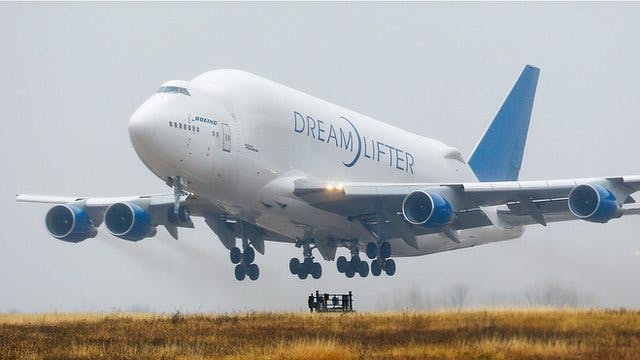Ask The Pilot: How much runway does an aircraft need to take off?
Last week saw Boeing embarrassed by its gigantic 747 ‘Dreamlifter’ freighter landing at the wrong airport in Wichita, Kansas.
The Dreamlifter is a huge cargo plane, used to transport parts of its 787 Dreamliner. After departing from a stopover in New York (it started out in Italy), the crew landed at Colonel James Jabara Airport instead of the intended destination of McConnell Air Force Base – a different airport, just a few miles away in Kansas.

However, the runway at Jabara is 6,101 feet long, far shorter than the 9,199 feet of runway that is optimal for a 747 taking off. And while it managed to land safely on a shorter than expected runway, on paper there wasn’t enough runway for it to take off again. In the end – after dwarfing the smaller runway overnight while many technical calculations were made – thankfully the Dreamlifter managed to take off and reposition without incident.
Since this incident I have been asked the same two questions many times:
- How can an aircraft land at the wrong airport?
- How much runway does a jet need to take off?
So here are the answers:
How can an aircraft land at the wrong airport?
For me there are two possible explanations for an aircraft landing at the wrong airport:
A) The wrong airport was entered into the flight deck computers (often called the FMS, Flight Management System).
Like any computer, a modern aircraft will comply with its instructions and has limited ability to challenge human input errors that are not dangerous.
B) The pilots misidentified the airport and manually landed on the wrong runway.
Often the causes of misidentification are: Pilots being unfamiliar with the region; poor weather; both airports being in close proximity with similar orientated runways.
What is surprising in this recent incident, is that Air Traffic Control (ATC) did not spot the aircraft lining up at the wrong runway. Pilots and ATC work together to prevent incidents and in this case it looks like both are responsible.
How much runway does a jet need to take off?
Aircraft manufacturers produce complex calculations to determine the required take off distance for every flight scenario. Factors that determine the required take off distance include:
- The aircraft design
- Aircraft configuration (eg flap settings)
- Temperature
- Wind direction and strength
- Runway surface and slope.
Each aviation region has regulators that oversee these performance calculations. In Europe, aircraft manufacturers follow the European Aviation Safety Agency (EASA). While in the USA its the Federal Aviation Authority (FAA).
Airlines or private jet operators rarely take off within the shortest distance possible, even when it’s perfectly safe to do so. Short distance take offs reduce the engine’s life and increase the maintenance fees. Therefore pilots are encouraged, when suitable conditions apply, to use reduced take-off thrust procedures. These take offs use less engine power – increasing the lifetime of the engines and saving unnecessary maintenance costs.
The Boeing Dreamlifter landing at the wrong airport is an example of an incident that was completely avoidable. Aircraft incidents are often caused by a chain of events involving many different parties. Whilst ultimately the aircraft’s captain is fully responsible, there will be many other people thinking this week that they contributed, or could have prevented, this airborne wrong turn.
Which aircraft can land at my chosen airport?
Visit our Destinations pages to search for an airport, and find out runway lengths; history; landing videos and other facts about global airports. Or call our 24-hour team on +44 1747 642 777 for advice on which aircraft are most appropriate for the runway length at your chosen airport.
Related content



